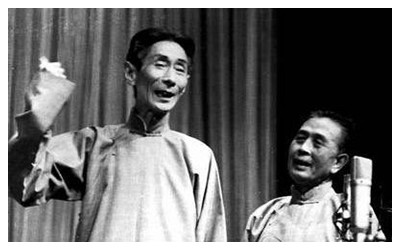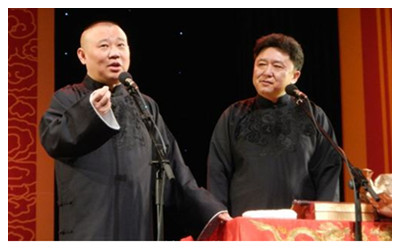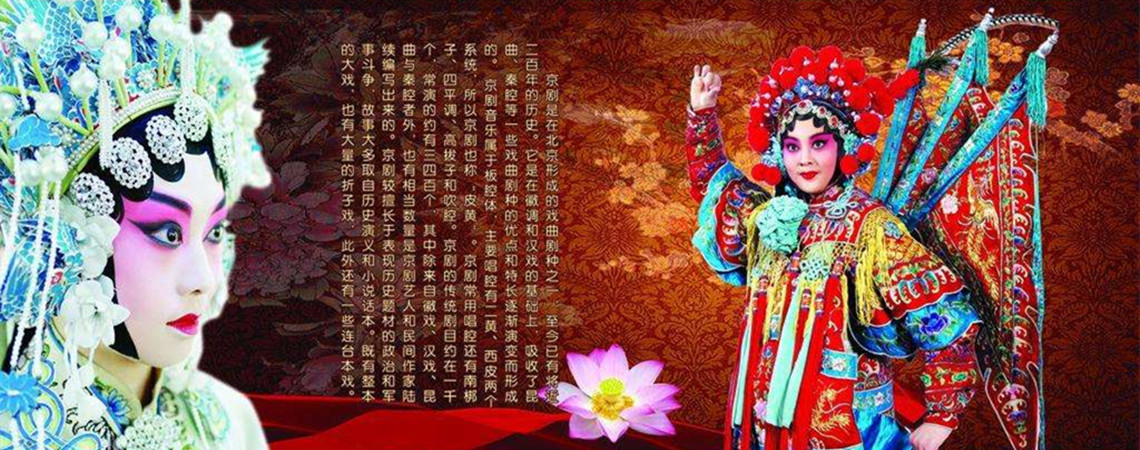Chinese Crosstalk is a kind of rap music arts. The word crosstalk was also known as imitation, originally referred to simulate other people's words and deeds, and then developed into crosstalk. Comic folk opera originated in northern China, already prevalent in the Ming Dynasty.

Crosstalk was originated in North China and became popular in Ming Dynasty. With the development in Qing Dynasty and the Republic of China era, crosstalk gradually developed form one’s vocal imitation to stand-up comedy. Chinese crosstalk has three birthplace:
Beijing Tianqiao, Tianjin Quanyechang and Nanjing Confucius Temple. Crosstalk lay its foundation in folk life and society, thus making it popular among folk people.
The word crosstalk was also known as imitation, originally referred to simulate other people's words and deeds. Crosstalk was further developed with North China's folk opera, and integrated by other folk art forms, which is generally believed that it was formed in the period of the Emperor Xianfeng and Tongzhi of Qing Dynasty. After years of development, crosstalk eventually become the most-loved comic form.
In the late Qing years, crosstalk has formed its modern comic character and style. Crosstalk mainly use the
Beijing dialect. However, there are also some dialect crosstalk in different regions. Crosstalk draw extensively of the techniques of ventriloquist, storytelling and other art forms during the formation process. Chinese crosstalk is made up of four skills - speaking, imitating, teasing, and singing.
Zhang Sanlu is the earliest crosstalk performers in records. His artistic career began in the period of Emperor Daoguang in
Qing Dynasty. After 1949, a lot of crosstalk performers who began their career before the Chinese Communist Party was in power transformed the content of the crosstalk, got rid of many pornographic contents and those segment which play jokes on people’s physical defects. Crosstalk rapid spread and become a national and universal form of folk art. One reason for the popular of crosstalk is that it is a kind of sound-based art, suitable for radio to be popular as the main media.
In the period of General Line, a group of crosstalk in praise of the new society appeared. Among them, Ma Ji was the representative. Nevertheless, in the subsequent Cultural Revolution, many crosstalk artists have been suppressed, once making it extinct in
China. Only some type of praise-type crosstalk still be able to perform during the Cultural Revolution.
In the 1980s, under the impact of short sketch, crosstalk performances no longer be popular with television audience. Some new forms such as playing and singing comic crosstalk, comic opera, etc. develop, but the market is still large (at the same time, a lot of comic elements are absorbed into the short sketch). However, crosstalk in this time still get some development: the emergence of a new generation of actors and all kinds of content and form of new comic scripts constantly on stage. During this period, among various sizes literary occasions, crosstalk protagonist is still entertaining the masses.
In the late 1990s, crosstalk began to decline, fewer new scripts appeared. At the same time, many well-known actors left the stage and engaged in other work. But the new actors cannot take over. The status of crosstalk gradually replaced by the growing short sketches.
All in all, the content of crosstalk is a comedy comic art and the form of which is a dialogue art. The characteristics of crosstalk in content and form are not isolated from each other, but contains mutual interpenetration, interdependence and mutual transformation. Crosstalk is a unique invention of Chinese people and it is a unique treasure in Chinese culture.

The earliest ancestor of crosstalk is Zhang Sanlu and the major schools are Hou (Baolin) School, Ma (Sanli) School, and Chang (Baokun) School and so on. The great crosstalk performers are: Hou Baolin, Ma Sanli, Chang Baokun, Su Wenmao, Liu Baorui and others. By the end of 20 century, many famous crosstalk performers died, and then the crosstalk career was on the decline.
Since 2005, with the spread of online video sites and other new media, the comedian Guo Degang and DeYun Community meteoric rise. The public attention again focused on this comic arts so that crosstalk achieved the second renaissance.
According to number of people:
Monologue Comic Talk: generally performed by one person. It is a long crosstalk which pays more attention to jokes.
Cross Talk: generally performed by two persons. One of them make jokes or make comical gesture and the other one coordinate with him.
Group Crosstalk: the number of performers is three or more.
According to the content:
Sarcastic Crosstalk: can satire at the performers themselves or others.
Praise-type Crosstalk: mainly performed in
China mainland. Its function is to coordinate with the government’s policies and guidelines.
Recreational Crosstalk: generally performed during festivals.

 Crosstalk was originated in North China and became popular in Ming Dynasty. With the development in Qing Dynasty and the Republic of China era, crosstalk gradually developed form one’s vocal imitation to stand-up comedy. Chinese crosstalk has three birthplace: Beijing Tianqiao, Tianjin Quanyechang and Nanjing Confucius Temple. Crosstalk lay its foundation in folk life and society, thus making it popular among folk people.
Crosstalk was originated in North China and became popular in Ming Dynasty. With the development in Qing Dynasty and the Republic of China era, crosstalk gradually developed form one’s vocal imitation to stand-up comedy. Chinese crosstalk has three birthplace: Beijing Tianqiao, Tianjin Quanyechang and Nanjing Confucius Temple. Crosstalk lay its foundation in folk life and society, thus making it popular among folk people. The earliest ancestor of crosstalk is Zhang Sanlu and the major schools are Hou (Baolin) School, Ma (Sanli) School, and Chang (Baokun) School and so on. The great crosstalk performers are: Hou Baolin, Ma Sanli, Chang Baokun, Su Wenmao, Liu Baorui and others. By the end of 20 century, many famous crosstalk performers died, and then the crosstalk career was on the decline.
The earliest ancestor of crosstalk is Zhang Sanlu and the major schools are Hou (Baolin) School, Ma (Sanli) School, and Chang (Baokun) School and so on. The great crosstalk performers are: Hou Baolin, Ma Sanli, Chang Baokun, Su Wenmao, Liu Baorui and others. By the end of 20 century, many famous crosstalk performers died, and then the crosstalk career was on the decline. Ask Questions ?
Ask Questions ?